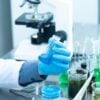According to the Center for Disease Control and Prevention, iron deficiency is the most common nutritional deficiency [I]. This is especially true amongst pregnant women and children. Without enough iron, we can feel incredibly weak and lethargic. This is because the body needs iron to produce hemoglobin.
Hemoglobin is a substance in red blood cells that allows the cells to carry oxygen to all of the tissues in your body. After it drops off oxygen, hemoglobin picks up carbon dioxide, which is taken to your lungs for elimination when you exhale. When you don’t have enough iron, the availability of oxygen to the tissues of your body decreases, which in turn decreases energy metabolism, resulting in severe fatigue.
Iron also plays an important role in body temperature regulation as well as the production of connective tissues in the body and neurotransmitters in our brain. It also helps to maintain the immune system.
Are You Absorbing Enough Iron?
Heme vs. Nonheme
There are two forms of iron; heme and nonheme. Heme iron is found in animal sources such as liver, beef, poultry, and shellfish. Nonheme iron is found in plant sources such as legumes, leafy vegetables, and mushrooms. The body’s ability to absorb heme iron is higher than absorption of non-heme sources, making vegetarians more prone to iron deficiency.
The absorption of non-heme iron, however, can be increased by adding foods to the meal that are rich in vitamin C. For instance, adding a bit of red pepper to your legume dish will increase the absorption of your iron and add some interest and flavor as well. It is especially important for vegans to be aware that beans are your best sources of iron and that adding red and green peppers (vitamin C) to your bean dishes will enhance iron’s absorption.
The Necessity of Stomach Acid
Stomach acid (HCL) is crucial for iron to be absorbed by the body. If your digestion has shut down because of stress, your stomach won’t secrete the HCL needed to absorb iron. Use of antacids such as Tums® neutralize HCL and can also decrease iron absorption. You can eat the most iron-rich meal, but if you aren’t digesting it, it will not do you any good.
The “Meat Factor”
Another factor that can help with non-heme iron absorption is something called the “meat factor.” This may frustrate vegans a bit, but when you consume even a tiny amount of meat with non-heme iron containing grains, legumes, or vegetables, you increase the iron’s bioavailability [II]. Experts are uncertain as to why this occurs.
Phytates & Polyphenols
An additional factor that you should know about iron is that the phytates found in grain and legume products can bind to iron, making it unavailable for absorption. So, any time a grain or legume is consumed, be sure that it has been soaked overnight to reduce phytate content.
Polyphenols, which are compounds found in tea, coffee, and red wine, also inhibit your body’s ability to absorb iron. For instance, if you were to consume one cup of coffee or tea with a meal, you may be decreasing non-heme iron absorption by 40-70%!
Iron Supplementation
Iron supplementation is sometimes necessary and can be especially important after blood loss (such as post-menstruation) or during pregnancy. Supplemental iron is available in two forms: ferrous iron (FE2+) and ferric iron (FE3+). Of these, the ferrous forms are best absorbed by the body.
Iron toxicity from foods is rare; most often toxicity results from too much supplementation. A good way to tell if you’ve had too much iron is to pay attention to your stools. In an attempt to eliminate iron, your body will pass it in your stools, turning them black. If you are struggling with severe constipation, this can be another sign of too much iron.
Recommended Daily Allowance (RDA)
Men 8 mg/day
Women 18 mg/day
Upper Level Dosage (UL) 45 mg/day
Food Sources of Iron
Animal sources: clams, liver, turkey giblets, spleen, and beef
(Heme Iron)
1 cup cooked clams— 31.7 mg
1 top sirloin beefsteak— 6.9 mg
Plant sources: white beans, lentils, garbanzo beans, pumpkin seeds, mushrooms, and brewer’s yeast
(Nonheme Iron)
1 cup raw winged beans— 24.5 mg
1 cup raw kidney beans— 17.2 mg
1 cup raw garbanzo beans— 16.6 mg
1 cup raw lentils— 14.5 mg
1 cup sesame seeds— 10mg
Another little tip is to cook your foods in a cast iron pan! Not only is it much safer to use than non-stick teflon versions, but it also enriches your dish with this very important trace mineral.
Resources
[I] “Recommendations to Prevent and Control Iron Deficiency in the United States”. Center for Disease Control, 1998; 47(RR-3);1-36. Web. May. 2016. <https://www.cdc.gov/mmwr/preview/mmwrhtml/00051880.htm>.
[II] Richard F. Hurrell, Manju B. Reddy, Marcel Juillerat, James D. Cook. “Meat Protein Fractions Enhance Nonheme Iron Absorption in Humans”. J. Nutr. November 2006; vol. 136 no. 11 2808-2812. Web. May. 2016. <http://jn.nutrition.org/content/136/11/2808.full>.





